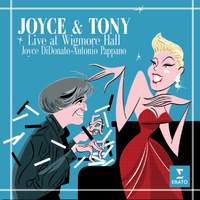Interview,
Joyce DiDonato
 The Wigmore Hall played host to a particularly starry line-up of singers last year, but even in such exalted company Joyce DiDonato's two recitals there in the early autumn stood out as one of the season's high points. It helps that the vivacious American mezzo was joined by no less than Sir Tony Pappano at the piano - not only have the two notched up numerous Rossini triumphs in the opera-house and on the concert-platform, but their exuberant musical personalities seem to be a match made in heaven when it comes to song repertoire.
The Wigmore Hall played host to a particularly starry line-up of singers last year, but even in such exalted company Joyce DiDonato's two recitals there in the early autumn stood out as one of the season's high points. It helps that the vivacious American mezzo was joined by no less than Sir Tony Pappano at the piano - not only have the two notched up numerous Rossini triumphs in the opera-house and on the concert-platform, but their exuberant musical personalities seem to be a match made in heaven when it comes to song repertoire.
Kicking off with a blistering account of Haydn's twenty-minute cantata Arianna a Naxos (hell surely hath no fury like this lady scorned!), this is very much a recital of two halves - the first part of the concert is all-Italian (also including Joyce's trademark Rossini, and some gorgeously schmaltzy songs by the relatively little-known twentieth-century composer Francesco Santoliquido), whilst the second focuses on The Great American Songbook, with the two performers sparking off one another quite delightfully in songs by Irving Berlin, Jerome Kern, Richard Rodgers and more. The sassy narcissism of Amor (from Bill Bolcom's marvellous Cabaret Songs) comes across brilliantly, and DiDonato's knack of making familiar songs sound fresh and sincere pays dividends in 'Can't help lovin' dat man' (from Showboat) and Somewhere over the rainbow (something of a signature-song for the Kansas-born mezzo).
I got in touch with Joyce yesterday over email to find out a bit more about her relationships with the accompanist and venue, the challenges of recording live, and how she approaches 'crossing over' into music-theatre territory…
You’ve been quite a regular visitor to the Wigmore over the past ten years: what’s special about this venue for you?
There is an immediacy and an intimacy in the Hall that is utterly unique in the world. Of course there is the famed acoustic which allows the performer to take unparalleled risks, opening up the possibility of a deeper expansion of expression, but the closeness of the audience breeds a spectacular chance to communicate beyond what one normally finds in larger venues.
How do you feel about recording live like this? Are you more cautious when the red lights on, or do you approach the concert as you would another other live performance?
I prefer recording live in front of an audience rather than in the studio so much, because it keeps the element of direct communication ALIVE, which can sometimes be lost when you’re on your own in a studio. We were lucky with this because we did two concerts, both of which were recorded - so I knew that if I missed something on the first night, I had a second chance, which allowed me to relax. However, the art of recording is quite a different beast than performing live, and I think over the years, I’ve learned more and more how to take the same kinds of risks I take in live performance, hopefully giving birth to a recording that loses no vitality or immediacy of expression.
Where did you come across those Santoliquido songs? They're so beautiful, and were totally unknown to all of us in the Presto office!
The BRILLIANT Glendower Jones, the absolute expert on vocal literature, sent those to me, when I asked him, “Glendower, send me anything you have that’s unknown, Italian, and romantic.” I think they are a superb find, and allow me to approach a repertoire that often isn’t available to me: something quasi Puccini-esque. I am SO happy Tony embraced them as he did, and that we could give the premiere recording of them!
How does it feel to give a song-recital with a pianist you’ve worked with so closely in the opera-house?
One word: SUBLIME. In every single way.
How much do you alter your approach to vocal production and colour for the lower-lying music-theatre repertoire? Do you actually ‘belt’, or find another way around it?
I actually don’t consciously alter that much, but simply enter into the musical language of the composer, and concentrate fully on the text. Without thinking “OK, 'I love a piano' needs to be belted”, I instinctively simply spoke the words, and … well, I don’t know if I can say I belted the lyrics, but I just brought the color I thought it needed. And had a BLAST doing it!
As well as the show songs on this disc, you’ve recently recorded songs from Carousel for John Wilson; are there any particular music-theatre roles you covet, and can you ever see yourself doing any on stage?
MAME! GYPSY! ELIZA!!! I love that music so much, and it’s where I come from in terms of theater; whether that ever translates to my actually performing these roles, I can’t envision it. However, I have learned never to say never!
'Joyce and Tony - Live at the Wigmore Hall' is out now on Erato.
Available Formats: 2 CDs, MP3, FLAC



